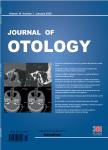A child with severe inner ear malformations with favorable hearing utilization and balance functions after wearing hearing aids
A child with severe inner ear malformations with favorable hearing utilization and balance functions after wearing hearing aids作者机构:National Institute of Sensory Organs National Tokyo Medical Center Tokyo Japan Department of OtolaryngologyeHead and Neck Surgery Nihon University School of Medicine Tokyo Japan Department of Speech Language and Hearing Therapy Mejiro University Saitama Japan Kawagoe Otology Institute Saitama Japan
出 版 物:《Journal of Otology》 (中华耳科学杂志(英文版))
年 卷 期:2017年第12卷第1期
页 面:41-46页
核心收录:
学科分类:1003[医学-口腔医学] 1002[医学-临床医学] 100213[医学-耳鼻咽喉科学] 10[医学]
基 金:This research did not receive any specific grant from funding agencies in the public commercial or not-for-profit sectors
主 题:Congenital hearing loss Inner ear malformations Rotation chair test
摘 要:Infants with congenital deafness caused by severe bilateral inner ear malformations frequently suffer from severe hearing loss and poor balance. Unfortunately, the use of hearing aids is usually ineffective in recovering hearing, necessitating cochlear implants. We report a case of a 6-year-old boy with congenital deafness and bilateral inner ear malformations(right side, incomplete partition type I [IP-I]; left side, common cavity deformity). Hearing aids had a remarkable effect in this patient, enabling sufficient and favorable hearing recovery such as to allow the patient to engage in daily conversations. Per-rotatory nystagmus was recorded on an electronystagmogram for both right and left rotations in a damped rotational chair test. It is rare for deaf children with severe bilateral inner ear malformation to demonstrate favorable development in hearing and good equilibrium function. Our findings suggest that auditoryevestibular hair cells in this patient may have been partially preserved despite IP-I in the right ear and common cavity deformity of the left ear.



